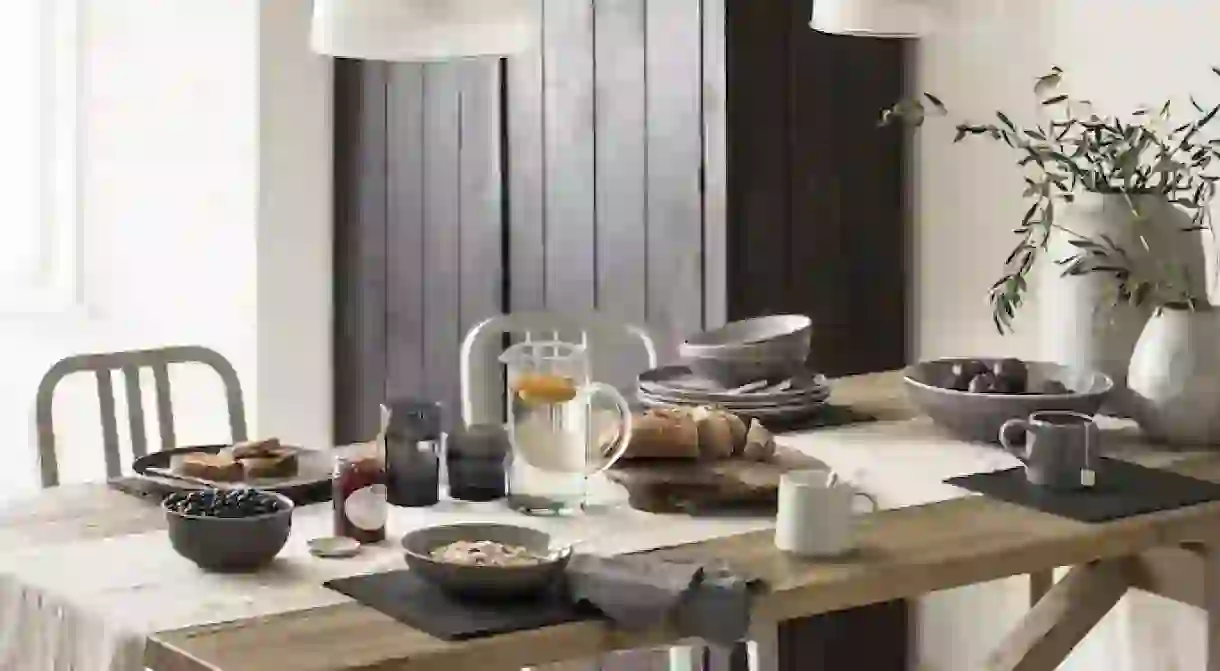12 Ways To Create The Danish Hygge Look At Home

There’s no getting away from it, with no less than ten books published on the subject this year, hygge (pronounced ‘heurgha’) is the new trend everyone is going crazy for. While this 18th-century Danish phenomenon applies to wellness and creating a happier life in general, it is also visually embodied in Danish decor – briefly, it’s a cosy, candle-lit sanctuary that’s serene, simple and shared with friends and family. Here are 12 inspiring decor ideas to add hygge to your own home for a healthier and happier lifestyle.
Keep it pure and simple
The Dane’s aren’t ones for embellishment or ‘loud’ colour schemes – the idea is to create a calm, serene space that is peaceful and free of clutter. Schemes are often purely monochrome, or a subtle mix of harmonious tonal shades.

Light more candles
The Danes light more candles per head than anywhere else in Europe and it’s not hard to see why. The warm glow of a candle simply can’t be replaced by artificial lighting; it’s about creating an inviting atmosphere and developing a soft, kinder form of light that’s perfect for relaxing and socialising – two things the Danes do best. Make sure they’re white and unscented though, the Danes are purists after all.

Stay in bed
There’s nothing better, or more luxurious, than spending an extra hour or two in bed. Luckily, hygge encourages this concept, whether it’s enjoying a Sunday doze, reading the morning paper, or having breakfast in bed. Create a cosy space to snuggle up in with plenty of layers – pile on the quilts, blankets and pillows for an indulgent place to relax.

Create a ‘hyggekrog’, or snug
Every home should have a little cosy nook to retreat to, preferably a window seat with a view looking out to nature. Add layers of cushions and a blanket and enjoy an afternoon of peace and quiet with a good book.

Get a fire going
Huddling around a roaring fire with family and friends is definitely part of the Danish culture – a wood-burning stove is a great energy-efficient option that the Danes would definitely approve of.

Introduce texture
The Danes use a mixture of materials and pattern as a way of adding character and interest to what would otherwise be a relatively minimalist scheme. They tend to introduce plenty of warm, natural materials, such as wood, leather and wool. The overall look still needs to adhere to a tight colour palette, however, to prevent it from clashing or being too distracting.

Get hygge with friends and family
If nothing else, one of the most important concepts of hygge is to get together with close friends and loved ones in a relaxed environment. Think less formal sit-down dinner party and more a get-together over a good bottle of wine, accompanied by hearty comfort food and homemade bakes served in rustic earthenware. Get the look with House of Fraser‘s Pebble dinnerware, pictured.

Take it outside
While hygge is usually associated with the chillier winter months, that doesn’t stop the Danes enjoying the great outdoors. Wrap up warm in faux fur and blankets, gather around a brazier and surround yourselves with lanterns. Finish it off with an indulgent hot chocolate or a mug of mulled wine. Hygge isn’t just for winter either; a day spent lingering over a leisurely picnic in the park or a barbecue at home is equally hygge.

Banish clutter
There’s a reason Japanese organisation guru Marie Kondo has sold millions of copies of The Life-Changing Magic of Tidying Up – so many of us desire a mess-free home, and none more so than the Danes. To truly embrace hygge, invest in clever storage solutions that can hide away any unwanted visual clutter to create a serene space.

Display treasured memories
Hygge is all about culturing an environment of happiness, so what better way than to put up a creative display of all your favourite family photos, travel paraphernalia, prints and paintings?

Create a spa-style sanctuary
Rather than a rushing for a quick shower in the morning, make sure your bathroom is a place for rest and rejuvenation. The trend for spa-style bathrooms is on the rise with even saunas – a favourite among Scandinavians – becoming more common in bathrooms across the globe. Simple is often best, however, and nothing beats a soak in a steaming hot bath. Invest in candles, fluffy bath robes, clever storage, good lighting and even a sound system to make your experience as relaxing as possible.

Embrace the old and imperfect
The Danes hate waste, so reuse and recycle objects where you can – get creative by upcycling antique pieces of furniture or find a new use of an old item. The good thing about hygge is that nothing has to be perfect; it’s more about the sentimentality of an old armchair that used to belong to a family member, for example, than buying lots of brand-new furniture.














